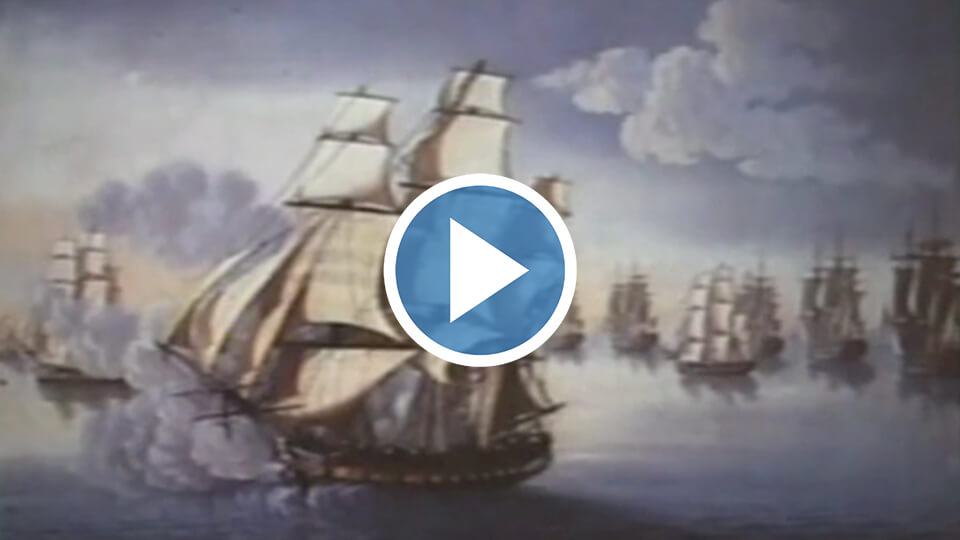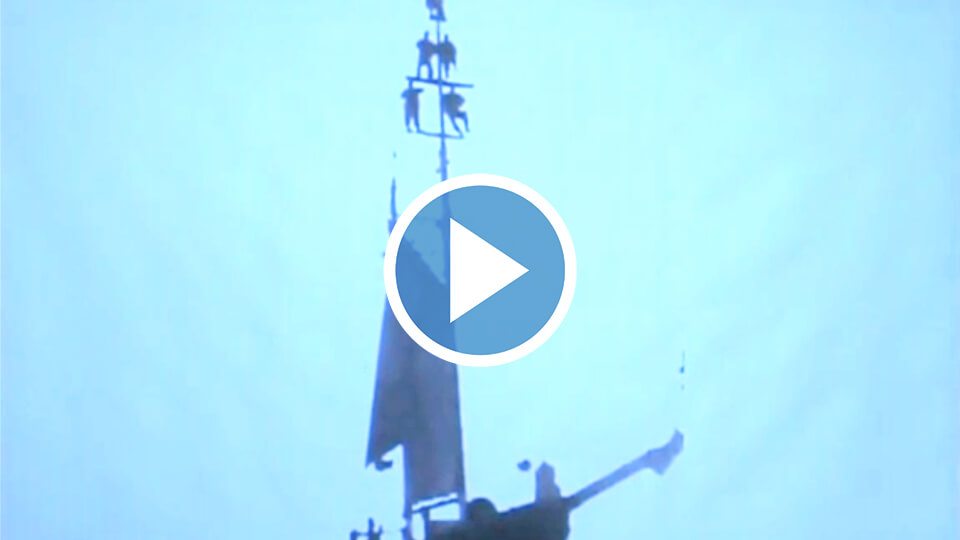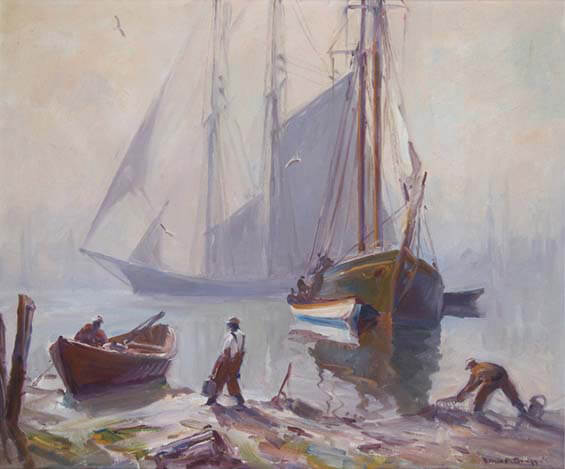
Emile A. Gruppé (1896-1978). The Bait Diggers, c. 1930s. Oil on canvas. Gift of Leicester J. Roberts, 2001 [Acc. # 2001.63.1]
Maritime & Fishing Industries
Fishing—the word is synonymous with Gloucester. For 400 years, the ocean’s bounty and beauty has generated Gloucester’s livelihood and inspired countless artists and writers. But while the fishing industry has brought about artistic inspiration and wealth, it also holds conflict, oppression, and danger. Countless lives have been lost at sea. And for more than 200 years, fishing also served as the primary but unseen link between this rising city and a lucrative slave trade conducted nearly 3,000 miles away in the former Dutch colony of Surinam. This week, the CAM Video Vault offers three takes on Gloucester's maritime past by exploring the long arc of its relationship to fishing. Although focused on different eras and perspectives, the videos are thematically linked by our fascination with and appreciation for Gloucester’s maritime story.
While none of the Video Vault features this week explore fishing's connection with the slave trade in the 18th and 19th centuries, we encourage you to learn more about these connections at capeannslavery.org, and to learn more about Cape Ann before the 20th century, visit our online exhibit from the CAM Library & Archives. ■
The Empire and the Seaport
Our first lecture takes us to the decades immediately following the American Revolution. In this presentation, The Empire and the Seaport: Trading Overseas in the Early Republic, Robert Booth contrasts Salem’s rise as a trading powerhouse in the first decades after the Revolution with Gloucester’s less ambitious, less lucrative but more steadfast maritime economy. Salem’s leading families emerge in this presentation as cutthroat rivals, which, despite intermarrying, aligned their financial, church and especially political interests against one another, with Jeffersonian Republicans squaring off against Hamiltonian Federalists. Within 50 years of 1776, however, the wealth they had acquired from privateering and the lucrative relationships they had nurtured with spice traders and cotton moguls in the West Indies and India, had all but disappeared due to national politics, technological change, and homicidal intrigue.
A Marblehead native, Robert Booth authored Death of an Empire: The Rise and Murderous Fall of Salem, America's Richest City and wrote the authoritative guidebook, Boston’s Freedom Trail. He has been a leader of many efforts to preserve the North Shore’s colonial heritage. ■
For more info on the work of Gloucester historian John J. Babson, who is referenced during the lecture, visit the CAM Library & Archives’ archival collection.
All the Ships at Sea
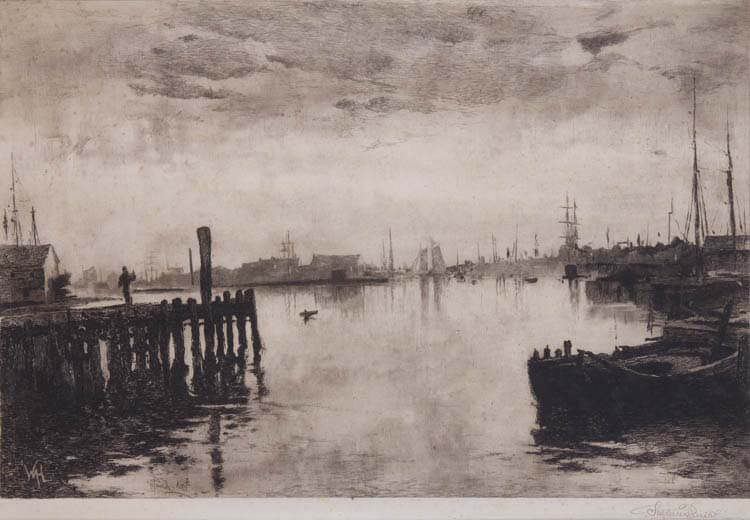
This work reflects the impact of William Morris Hunt on marine painting and is one influence that is discussed in the lecture. Stephen Parrish (1846-1938) - Gloucester Harbor (after William Morris Hunt), 1882. Etching on paper. Gift of Harold and Betty Bell, 1984. [#2451.09]
We next trace the rise of marine-inspired artists in the late 19th century with All the Ships at Sea - A Celebration of Cape Ann's Role in the Maritime Trades by William Trayes. This lecture highlights the long-time association of Cape Ann and Gloucester with a treasure trove of painters that sought authenticity in often romanticized, occasionally gritty images of ships, the sea and the shore. Trayes speaks fondly of the connections he made with maritime culture growing up in Rockport, sailing its waters and learning over time about the contributions of so many painters to Cape Ann’s reputation in the national pantheon of nautical art lore. He delights in telling the whimsical story of one maritime painter in particular who was never actually a painter but an itinerant hawker of paintings done by established artists who had grown tired of paying high commissions to gallery owners.
The late William Trayes of Rockport and Gloucester was an avid collector, which inspired his deep ventures into art history and his often personal connections with the artists that have contributed to Cape Ann’s art associations, galleries and schools. ■
Fish Strike of 1917
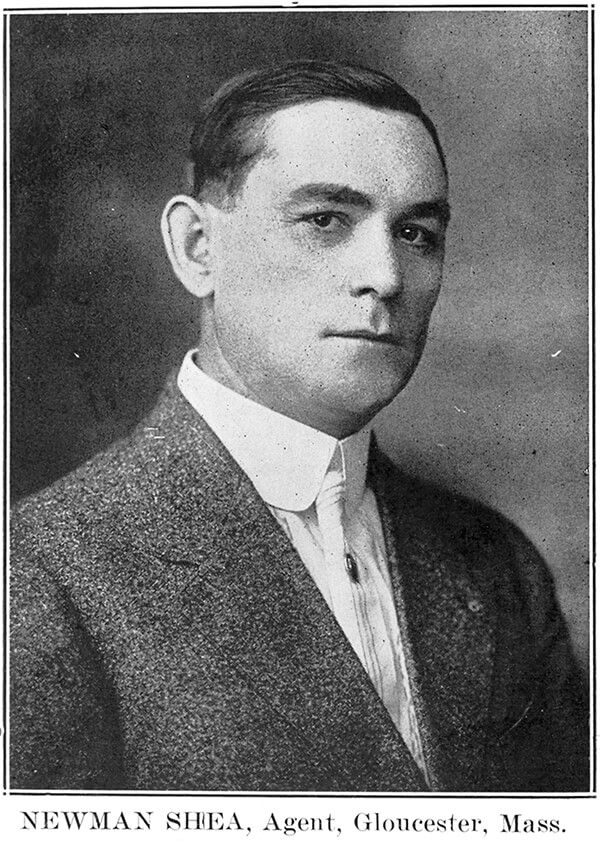
Newman Shea, Agent, Gloucester, Mass. From Fishermen’s Union of the Atlantic, 1923 yearbook. From the Collection of the Cape Ann Museum Library & Archives.
Lastly, we explore the fishing industry’s labor-management conflicts of the 1910’s and 1920’s through one of David Rich’s “Gloucester Rediscovery” lectures, titled: Charles Olson, Newman Shea and the Fish Strike of 1917. Rich outlines the contentious issues embroiling the Gloucester fishing community, the incipient union movement, and the experiments of cooperative fishing from 100 years ago. David Rich paints a vivid portrait of the grievances that sparked the union movement and recounts the clash between strikebreakers brought to Gloucester from Boston to suppress the striking fishermen, who stood their ground but eventually succumbed to pocketbook pressures and ethnic divisions. Rich pivots from these events to an encounter between the business agent for the fishermen’s union, Newman Shea, and the city’s foremost poet, Charles Olson, on the swordfish schooner Doris M. Hawes in 1936. Rich imagines a young Olson’s fascination with an aging Shea on the boat only to have Olson later recast Shea as an allegorical emblem in his epic poem, “Maximus,” but not in a flattering or historically accurate light.
David Rich is a Gloucester native who has extensively researched its fishing history and legendary characters. His approach to research extends beyond recounting events and historical characters by incorporating literary and artistic insights in his narratives. ■
To learn more about topics discussed in these lectures, and more relating to the Fisheries and Maritime history, visit the Cape Ann Museum Fisheries & Maritime Collection page on our website. And for a complete listing of all video lectures in the CAM Video Vault, visit our Video Lecture Finding Aids & Transcripts page.
Unsubscribe | Forward | View in browser
CAPE ANN MUSEUM
27 Pleasant Street, Gloucester, MA 01930
Cape Ann is one of the most important places in the history of American art and industry.
The Cape Ann Museum, thanks to supporters like you, celebrates the history and remarkable contributions of this place to the cultural enhancement of our community and the world at large - yesterday, today and tomorro


